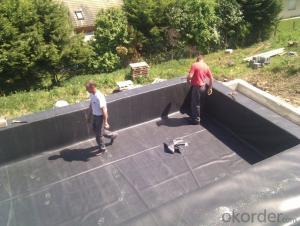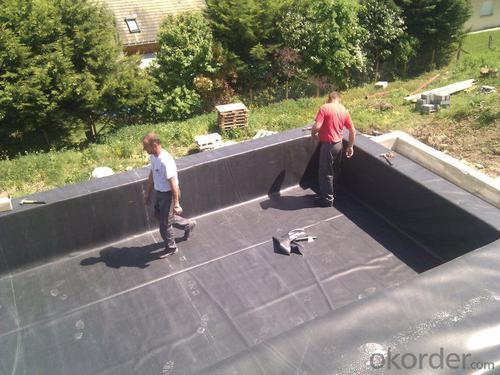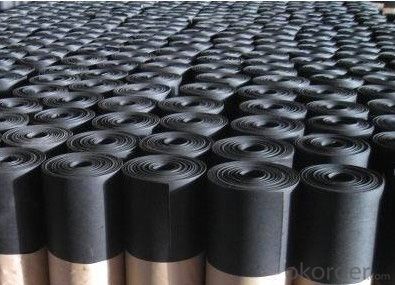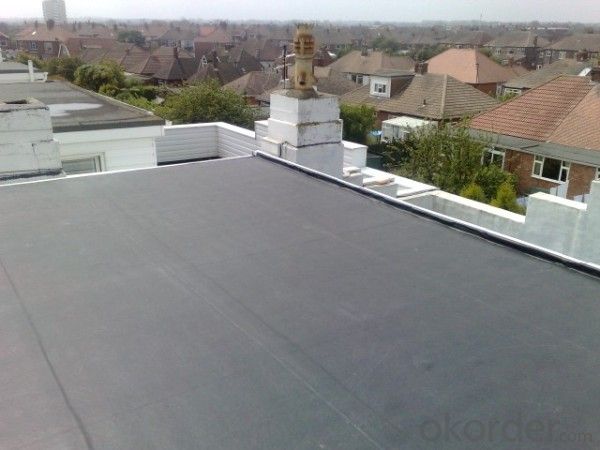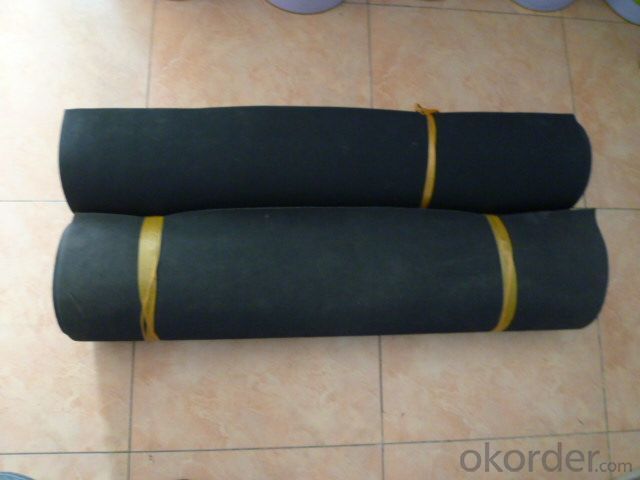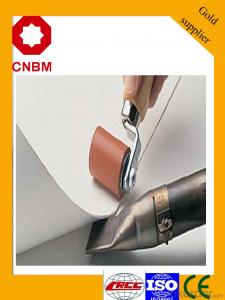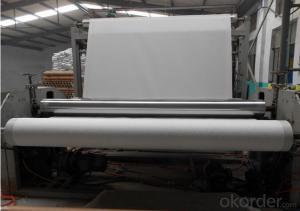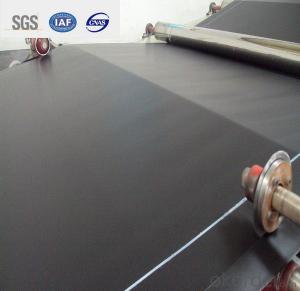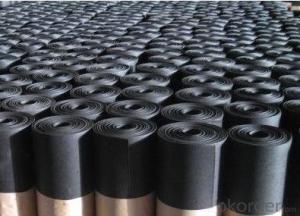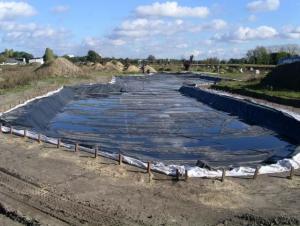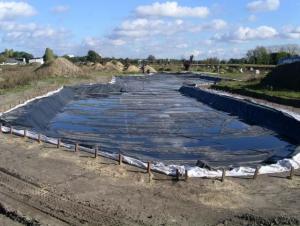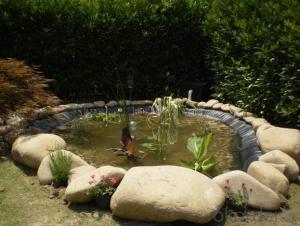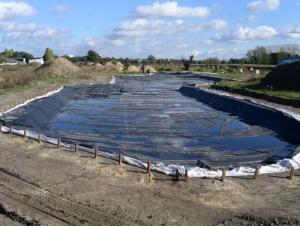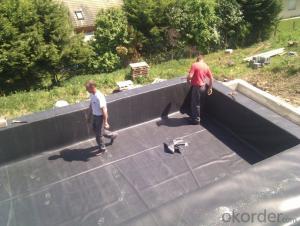EPDM Rubber Coiled Waterproof Membrane for Fish Pond
- Loading Port:
- Shanghai
- Payment Terms:
- TT OR LC
- Min Order Qty:
- 50000 m²
- Supply Capability:
- 5000000 m²/month
OKorder Service Pledge
OKorder Financial Service
You Might Also Like
EPDM Rubber Coiled Waterproof Membrane for Fish Pond
Description Of EPDM Rubber Coiled Waterproof Membrane for Fish Pond:
•EPDM waterproof sheet has excellent anti-ozone-aging performance, able to resist ultraviolet light and corrosion of many chemical corrosive materials in the atmosphere
•It has high tensile strength, high ductility and strong retractility, it has excellent crack resistance, able to effect waterproof function even with tiny vibration of buildings.
• Excellent resistance to ozone, oxidation and sunlight.
• Resistance to chemicals; resistant to most inorganic products.
Main Features of EPDM Rubber Coiled Waterproof Membrane for Fish Pond:
1>Excellent antiaging performance, service life up to 50 years
2>Working well with in 40C to 100C,it canbe constructed with a single layer in ambient temperature.
3>Waterproofing on various kinds of underground project,industrial of civil buildings and structures.
4>high extension rate, high tensile strength, small size changes at heat treatment
5>Good plant roots penetrability resistance and can be made waterproofing layer of planting roof
6>Special modified molecular structure ,effectively resolving the current domestic and foreign glue joint problem.
7>Good low temperature flexibility, and good performance of adapting to ambient temperature changes.
8>Convenient application ,solid joint, no environment pollution
9>chemical corrosion Resistance, can be used for special occasions
10>Convenient maitenance, low cost.
Specifications of EPDM Rubber Coiled Waterproof Membrane for Fish Pond:
| Material | EPDM Rubber |
| Size | 1.2m (width)*20m (length) or customized, weldable type 2.05m or 4m width |
| Thick | 1.2mm, 1.5mm, 2.0mm |
| Type | Vulcanized & Weldable |
| Pattern | Non-reinforced (homogeneous) |
| Certificate | ISO9001/14001 |
Applications of EPDM Rubber Coiled Waterproof Membrane for Fish Pond:
Widely used in roofs, basement, toilet ,swimming pool, and all kinds of industry and civil building waterproofing, reservoir, vivicism, bridge, underground, tunnel and dam waterproofing ,especially to the keystone waterproofing projects which is durability, high corrosion resistance and easy deformation.



IMages of EPDM Rubber Coiled Waterproof Membrane for Fish Pond:




FAQ of EPDM Rubber Coiled Waterproof Membrane for Fish Pond:
1. What are we supplying?
We are specialized in producing Colorful Asphalt Roof Shingle, SBS/APP modified bitumen waterproof membrane, Self adhesive bitumen waterproof membrane, PVC waterproofing membrane, EPDM rubber roofing membrane, Single Component Polyurethane Waterproof Coating, and Spray Polyurea Waterproof Coating
.
2. How Many years experience do we have?
We have been exported to more than 20 countries in the past 15 years.
3. How long do we usually reply your request?
We always reply our customer within 24 hours.
- Q: Can a waterproofing membrane be used on plywood?
- Plywood, a commonly used material in construction, is often employed as a subfloor or as a foundation for different types of flooring. However, it lacks natural waterproofing properties and is vulnerable to moisture-related damage. To safeguard plywood from water harm, the application of a waterproofing membrane is recommended. These membranes serve as barriers, preventing water from infiltrating the plywood and thereby keeping it dry while deterring the growth of rot or mold. Waterproofing membranes find utility in various settings including bathrooms, kitchens, decks, and roofs. It is essential to select a suitable membrane for plywood and adhere to the manufacturer's instructions for proper installation in order to achieve optimal outcomes.
- Q: What are the benefits of using a waterproofing membrane?
- The benefits of using a waterproofing membrane include protecting the structure from water damage, preventing leaks and seepage, extending the lifespan of the building, reducing maintenance and repair costs, and creating a healthier and more comfortable environment by preventing mold and mildew growth.
- Q: Waterproof building materials after the construction of drums, bubble is what reason?
- Reason 3: synthetic polymer waterproofing membrane construction, if the adhesive is not fully dry on the eager to paving the membrane, resulting in a solvent residue in the coil inside, when it evaporates, it will form a bubble. Control measures: the use of cold and cold method of paving, the brushing of the adhesive to be uniform, to be dry when the handle (refers to touch) is not bonded, before paving the membrane, while compaction. In particular, to prevent the accumulation of adhesive too thick, dry operation caused by the film from the drum.
- Q: Can a waterproofing membrane be used on concrete walls?
- Yes, a waterproofing membrane can be used on concrete walls. Waterproofing membranes are designed to provide a protective barrier against water penetration, and they can be applied to various surfaces including concrete walls. These membranes are typically made of materials such as modified bitumen, rubberized asphalt, or synthetic polymers, which are highly resistant to water and moisture. Applying a waterproofing membrane on concrete walls can effectively prevent water seepage, dampness, and potential damage caused by water infiltration. The membrane acts as a barrier, preventing water from permeating through the concrete and reaching the interior spaces. It also helps to maintain the structural integrity of the concrete by minimizing the risks of cracks, efflorescence, and other forms of moisture-related deterioration. There are different types of waterproofing membranes available in the market, such as sheet membranes, liquid membranes, and cementitious coatings. The choice of the membrane depends on factors such as the specific application, the degree of water exposure, and the condition of the concrete wall. It is essential to select a membrane that is compatible with the concrete and provides long-lasting waterproofing protection. Before applying the membrane, it is crucial to prepare the concrete surface properly. This may involve cleaning, repairing any cracks or imperfections, and ensuring that the surface is dry and free from any contaminants. The membrane is then installed according to the manufacturer's instructions, typically by adhering it to the concrete or by applying a liquid membrane using a brush or roller. In conclusion, a waterproofing membrane can be used on concrete walls to effectively protect them from water infiltration. This can help to maintain the durability and longevity of the concrete, as well as prevent potential water damage to the interior spaces. However, it is essential to choose the right type of membrane and follow proper installation procedures for optimal results.
- Q: Can a waterproofing membrane be used for concrete bridge decks?
- Yes, a waterproofing membrane can be used for concrete bridge decks. A waterproofing membrane is a thin layer of material that is applied to the surface of the bridge deck to prevent water infiltration and protect the concrete from deterioration caused by moisture. This membrane is designed to be flexible and durable, providing a barrier against water while allowing for the movement and expansion of the bridge deck. It is typically applied in multiple layers and can be either hot-applied or cold-applied, depending on the specific project requirements. The use of a waterproofing membrane on concrete bridge decks helps to extend the service life of the structure by preventing water damage, reducing the need for frequent repairs and maintenance, and improving overall structural integrity.
- Q: Are waterproofing membranes resistant to corrosion?
- Indeed, waterproofing membranes exhibit remarkable corrosion resistance. Engineered with the sole purpose of forming a formidable shield against water, moisture, and other destructive agents, these membranes are meticulously crafted using non-corrosive materials such as synthetic polymers like PVC or TPO, as well as rubberized asphalt. Thanks to their exceptional resistance to water, moisture, chemicals, and other corrosive substances, structures can be effectively safeguarded against corrosion and enjoy an extended lifespan when these waterproofing membranes are skillfully installed and diligently maintained.
- Q: How does a waterproofing membrane handle seismic movements?
- Waterproofing membranes are specifically designed to safeguard structures like buildings, basements, and roofs against water intrusion and leaks. Their primary purpose is to prevent water damage, but they also play a role in handling seismic movements to some degree. Seismic movements, also known as earthquakes, exert immense stress and strain on structures, resulting in cracks, fissures, or even complete building collapses. These movements create powerful vibrations and ground motion that can compromise the integrity of waterproofing systems. To counter seismic movements, a correctly installed waterproofing membrane possesses flexibility and elasticity. It can absorb and distribute the energy produced by ground motion, thereby minimizing the impact on the structure and reducing the chances of water infiltration. One way in which a waterproofing membrane deals with seismic movements is through its capacity to elongate and stretch. During an earthquake, the membrane can deform and adjust to the structure's movement without tearing or breaking. This flexibility enables it to maintain its waterproofing abilities even in extreme conditions. Moreover, waterproofing membranes often incorporate reinforcement layers, such as polyester or fiberglass, to enhance their tensile strength and resistance to tearing. These reinforcement layers help the membrane withstand the dynamic forces exerted during seismic events, ensuring its integrity and preventing water from seeping into the structure. It is crucial to note that while a waterproofing membrane can handle seismic movements to a certain extent, it cannot replace proper structural design and earthquake-resistant construction practices. Structures must be engineered to withstand seismic forces, and waterproofing systems should be installed following industry standards and guidelines to guarantee their effectiveness and durability during earthquakes. In conclusion, a waterproofing membrane can effectively handle seismic movements by being flexible, elastic, and tear-resistant. It absorbs and disperses the energy generated by seismic events, safeguarding the structure from water infiltration and minimizing potential damage. However, it is imperative to combine appropriate structural design and construction techniques with a dependable waterproofing system to ensure overall safety and resilience during earthquakes.
- Q: Can a waterproofing membrane be used on concrete block walls?
- Yes, a waterproofing membrane can be used on concrete block walls. Concrete block walls are susceptible to water penetration, which can lead to issues such as mold, mildew, and structural damage. A waterproofing membrane is a protective barrier that is applied to the surface of the concrete block walls to prevent water from seeping through. It acts as a barrier against moisture, creating a watertight seal and preventing water from entering the interior of the walls. This helps to maintain the integrity of the walls and protect against water-related damages. However, it is important to ensure that the waterproofing membrane is properly installed and that any existing cracks or gaps in the concrete block walls are adequately sealed before applying the membrane.
- Q: Are waterproofing membranes resistant to saltwater?
- Yes, waterproofing membranes are generally resistant to saltwater. These membranes are designed to create a barrier that prevents water from penetrating through surfaces such as roofs, walls, or foundations. They are made from materials like rubber, polyethylene, or PVC, which are inherently resistant to the corrosive effects of saltwater. This resistance allows waterproofing membranes to effectively protect structures and surfaces from water damage, even in saltwater environments. However, it is essential to choose a waterproofing membrane specifically designed for saltwater applications to ensure optimal performance and longevity.
- Q: Can a waterproofing membrane be used in showers and wet areas?
- Yes, a waterproofing membrane can be used in showers and wet areas. Waterproofing membranes are designed to provide a protective barrier against water penetration, making them ideal for use in areas that are constantly exposed to water, such as showers and wet areas.
Send your message to us
EPDM Rubber Coiled Waterproof Membrane for Fish Pond
- Loading Port:
- Shanghai
- Payment Terms:
- TT OR LC
- Min Order Qty:
- 50000 m²
- Supply Capability:
- 5000000 m²/month
OKorder Service Pledge
OKorder Financial Service
Similar products
Hot products
Hot Searches
Related keywords
